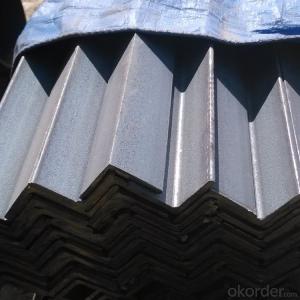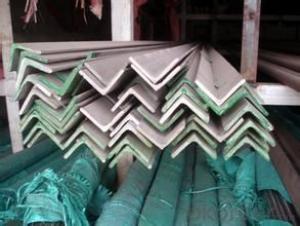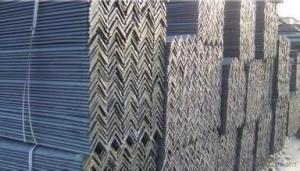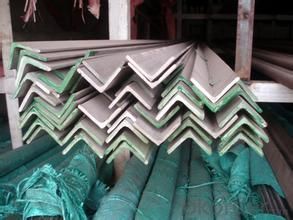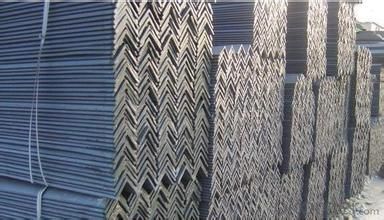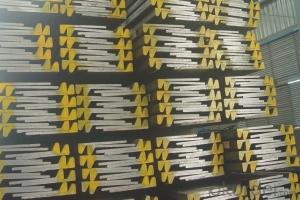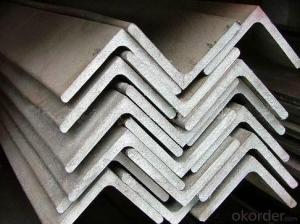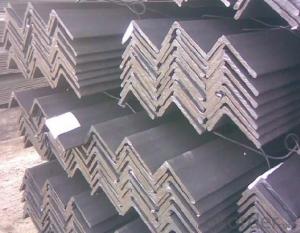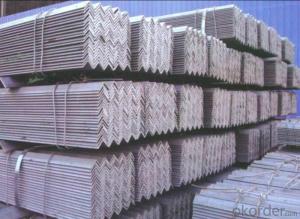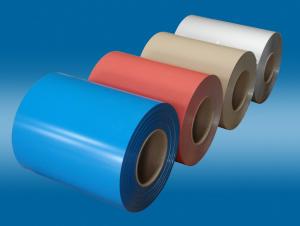EN10056 galvanized angle steel for construction
- Loading Port:
- Tianjin
- Payment Terms:
- TT OR LC
- Min Order Qty:
- 25 m.t.
- Supply Capability:
- 10000 m.t./month
OKorder Service Pledge
OKorder Financial Service
You Might Also Like
Product Description:
Specifications of Equal Angle Steel
1.Standards:GB
2.Length:6m, 12m
3.Material:GBQ235, Q345 or Equivalent
4. Size:
Size (mm) | Mass (mm) | Size (mm) | Mass (mm) |
| 30*30*2.7 | 1.246 | 30*30*4 | 1.786 |
| 30*30*3.0 | 1.373 | 30*30*5 | 2.184 |
Usage & Applications of Equal Anlge Steel
Trusses;
Transmission towers;
Telecommunication towers;
Bracing for general structures;
Stiffeners in structural use.
Packaging & Delivery of Equal Angle Steel
1. Transportation: the goods are delivered by truck from mill to loading port, the maximum quantity can be loaded is around 40MTs by each truck. If the order quantity cannot reach the full truck loaded, the transportation cost per ton will be little higher than full load.
2. With bundles and load in 20 feet/40 feet container, or by bulk cargo, also we could do as customer's request.
3. Marks:
Color mark: There will be color marking on both end of the bundle for the cargo delivered by bulk vessel. That makes it easily to distinguish at the destination port.
Tag mark: There will be tag mark tied up on the bundles. The information usually including supplier logo and name, product name, made in China, shipping marks and other information request by the customer.
If loading by container the marking is not needed, but we will prepare it as customers' request.
*If you would like to get our price, please inform us the size, standard/material and quantity. Thank you very much for your attention
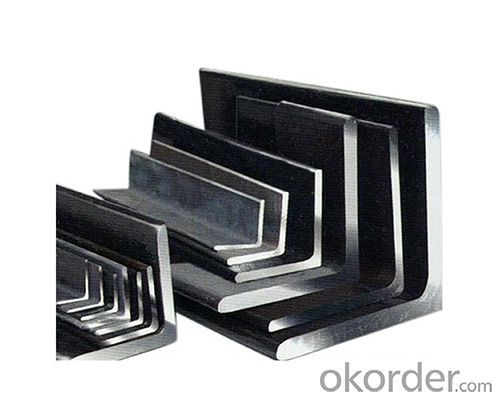

- Q:Are steel angles available in non-standard dimensions?
- Steel angles in non-standard dimensions can be obtained. Although standard steel angles are typically manufactured in specific sizes, such as 2x2 inches or 3x3 inches, there are manufacturers and suppliers capable of producing steel angles in custom sizes to fulfill specific project requirements. These custom sizes may involve varying leg lengths, thicknesses, or overall dimensions that are not commonly found in standard steel angles. Achieving the desired dimensions can be accomplished through processes like cutting, bending, and welding when fabricating custom steel angles. Nevertheless, it is important to consider that non-standard dimensions may result in additional time and cost for production compared to readily available standard sizes.
- Q:Can steel angles be used for decorative purposes?
- Yes, steel angles can definitely be used for decorative purposes. They can be shaped and designed in various ways to add a modern and industrial touch to interior or exterior spaces. Steel angles can be used as decorative accents, such as in furniture design, architectural details, or even as standalone decorative pieces. Their durability and versatility make them an excellent choice for adding a unique and stylish element to any space.
- Q:Can steel angles be painted or coated after installation?
- Yes, steel angles can be painted or coated after installation. Painting or coating steel angles provides an added layer of protection against corrosion, enhances their aesthetic appeal, and can help them blend in with their surroundings.
- Q:Can steel angles be used for structural purposes?
- Steel angles are a viable option for structural purposes. In construction and engineering projects, steel angles have a common application of providing support and stability. They are frequently utilized to reinforce and fortify various structural elements like beams, columns, frames, and trusses. The high strength and durability of steel angles make them capable of enduring heavy loads and forces. They possess versatility as they can be effortlessly welded, bolted, or screwed into position, facilitating convenient installation and adaptation to diverse design specifications. Furthermore, steel angles are accessible in multiple dimensions, lengths, and thicknesses, rendering them appropriate for a broad spectrum of structural uses.
- Q:Can steel angles be used for manufacturing storage racks?
- Yes, steel angles can be used for manufacturing storage racks. Steel angles are versatile and strong, making them an ideal choice for constructing storage racks. They provide stability and structural integrity to the racks, ensuring that they are capable of supporting heavy loads. Additionally, steel angles can be easily welded or bolted together, allowing for the creation of custom-sized racks that can meet specific storage requirements. The durability of steel angles also ensures that the storage racks can withstand wear and tear over time. Therefore, steel angles are commonly used in the manufacturing of storage racks in various industries such as warehousing, retail, and logistics.
- Q:How do steel angles contribute to the stability of a structure?
- A structure's stability is influenced by steel angles in several ways. Firstly, steel angles are widely used as structural members in buildings, bridges, and towers, providing strength and stability to the overall structure. Their unique shape, with one side longer than the other, enables them to withstand compression and tension forces, making them ideal for supporting heavy loads. Additionally, steel angles serve to create rigid connections between different structural components. By welding or bolting steel angles at critical joints, the load is evenly distributed, preventing excessive movement or deformation. This greatly enhances the stability and integrity of the structure, particularly in the face of dynamic loads such as wind or seismic forces. Moreover, steel angles can be effectively utilized as bracing elements. Bracing is essential for resisting lateral forces like wind or earthquake loads. By strategically placing steel angles diagonally between structural members, a triangulated system is formed, improving the overall stability of the structure. This bracing helps to minimize excessive sway or deflection, ensuring that the structure remains rigid and secure. Furthermore, steel angles possess exceptional durability and corrosion resistance, which is crucial for the long-term stability of a structure. They can withstand harsh environmental conditions, including moisture, UV radiation, and temperature fluctuations. This durability ensures that steel angles maintain their structural integrity over time, providing ongoing stability and safety. In conclusion, steel angles play a pivotal role in guaranteeing the stability of a structure. Their ability to withstand compression and tension forces, create rigid connections, act as bracing elements, and their durability make them indispensable in various construction projects. By incorporating steel angles in the design and construction process, engineers can enhance the stability, strength, and safety of the structure, ultimately providing a reliable and long-lasting solution.
- Q:What are the different types of steel angles used in shipbuilding?
- In shipbuilding, there are several types of steel angles that are commonly used for various structural purposes. These angles are typically made from high-strength steel and are designed to provide strength and stability to the ship's structure. Here are some of the different types of steel angles used in shipbuilding: 1. Bulb Angles: These angles are specifically designed for use in the construction of ship hulls. They have a bulbous shape on one side, which helps in distributing the load and providing additional strength and stability to the hull structure. 2. L-Shaped Angles: L-shaped angles, also known as unequal angles, are widely used in shipbuilding for framing and bracing purposes. These angles have one leg longer than the other, allowing them to be used in various applications where different lengths are required. 3. Equal Angles: Equal angles, also known as L-sections, have two legs of equal length and are commonly used in shipbuilding for framing and supporting structures. They provide uniform strength and can be used in a variety of applications, including bulkhead framing and deck support. 4. Flat Bars: Although not technically angles, flat bars are often used in shipbuilding for similar purposes. These bars have a rectangular cross-section and are typically used for reinforcement, framing, and connecting various structural components. 5. T-Sections: T-sections, also known as T-angles, have a T-shaped cross-section and are commonly used in shipbuilding for structural framing, reinforcement, and connecting different components. The vertical leg of the T-section provides additional strength and stability to the structure. 6. Z-Sections: Z-sections, also known as Z-angles, have a Z-shaped cross-section and are used in shipbuilding for various purposes, such as framing, bracing, and supporting structures. These angles offer excellent load-bearing capacity and are often used in applications where maximum strength is required. Overall, the choice of steel angles in shipbuilding depends on the specific requirements of the structure, including the load-bearing capacity, structural design, and intended use. The aforementioned types of steel angles provide a wide range of options to meet the diverse needs of ship construction.
- Q:What is the typical yield stress of steel angles?
- The typical yield stress of steel angles can vary depending on the specific grade and type of steel being used. However, for commonly used carbon steels, the typical yield stress ranges from 36,000 to 50,000 pounds per square inch (psi). This means that the steel angles can withstand a certain amount of stress or pressure before they begin to deform or permanently change shape. It is important to note that different steel alloys and treatments can result in varying yield stresses, so it is necessary to consult the specific specifications or reference materials for the particular steel angle in question.
- Q:What are the load-bearing capacities of steel angles?
- The load-bearing capacities of steel angles may differ due to various factors, such as the angle's size, thickness, and the type of steel used, as well as its specific application. Typically, steel angles are designed to offer structural support and can handle substantial loads. The load-bearing capacity of a steel angle is determined by its ability to withstand compression and tension forces, as well as its bending strength. These factors are influenced by the material properties of the steel, including its yield strength, tensile strength, and ductility. Steel angles find common usage in construction and engineering projects, where they are employed to support beams, frames, and structures. Engineers or designers usually specify the load-bearing capacity of a steel angle based on the project's specific requirements and the expected loads. Calculations and structural analysis, following engineering principles and standards, are typically carried out to determine the load-bearing capacity of a steel angle. These calculations take into account the angle's dimensions, support conditions, and the anticipated loads. To ensure that a steel angle's load-bearing capacity meets the necessary requirements for a given application, it is crucial to consult relevant engineering codes and standards provided by organizations such as the American Institute of Steel Construction (AISC) or British Standards Institution (BSI). In conclusion, the load-bearing capacities of steel angles can differ based on several factors. To accurately determine the load-bearing capacity of a specific steel angle for a given application, it is important to consult with a structural engineer or refer to appropriate engineering standards.
- Q:How do you calculate the load capacity of a steel angle?
- To calculate the load capacity of a steel angle, you need to consider several factors. Firstly, you need to determine the yield strength of the steel angle. This can be obtained from the manufacturer's specifications or by conducting tests. The yield strength is the maximum stress that the steel angle can withstand without permanent deformation. Next, you need to determine the moment of inertia of the angle section. The moment of inertia is a measure of the beam's resistance to bending. It can be calculated using the formula: I = (b * h^3) / 12, where b is the width and h is the height of the angle section. Once you have the yield strength and moment of inertia, you can use the formula for bending stress: σ = (M * c) / I, where σ is the bending stress, M is the applied moment, and c is the distance from the centroid to the extreme fiber. To calculate the load capacity, you need to consider the safety factor. The safety factor accounts for uncertainties and variations in loading conditions. It is typically specified by the design code or standard being used. To determine the load capacity, divide the bending stress by the safety factor: Load Capacity = σ / Safety Factor. It is important to note that the load capacity calculation assumes that the steel angle is perfectly straight, with no defects or imperfections. In real-world applications, additional factors such as residual stress, temperature effects, and dynamic loading should also be considered. It is recommended to consult with a structural engineer or refer to design codes and standards specific to your application to ensure accurate calculations.
1. Manufacturer Overview |
|
|---|---|
| Location | |
| Year Established | |
| Annual Output Value | |
| Main Markets | |
| Company Certifications | |
2. Manufacturer Certificates |
|
|---|---|
| a) Certification Name | |
| Range | |
| Reference | |
| Validity Period | |
3. Manufacturer Capability |
|
|---|---|
| a)Trade Capacity | |
| Nearest Port | |
| Export Percentage | |
| No.of Employees in Trade Department | |
| Language Spoken: | |
| b)Factory Information | |
| Factory Size: | |
| No. of Production Lines | |
| Contract Manufacturing | |
| Product Price Range | |
Send your message to us
EN10056 galvanized angle steel for construction
- Loading Port:
- Tianjin
- Payment Terms:
- TT OR LC
- Min Order Qty:
- 25 m.t.
- Supply Capability:
- 10000 m.t./month
Offcanvas right
OKorder Service Pledge
OKorder Financial Service
Similar products
New products
Hot products
Hot Searches
Related keywords
